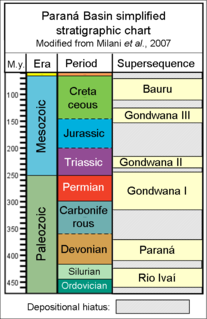 W
WThe Bajo de Véliz Formation is stratigraphic formation of the Paleozoic located in the Paganzo Basin, Argentina. This formation lies in the northwestern sector of San Luis, about 25 km west of Santa Rosa de Conlara. Containing a slice of the Carboniferous-Permian transition, it is one of the key upper Paleozoic successions characterizing that era in westernmost Gondwana, which South America was a part of in the Paleozoic.
 W
WThe Carapacha Formation is a geological formation of the Sierra de Calencó, Carapacha Basin of La Pampa Province, Argentina whose strata date back to the Artinskian to Wuchiapingian of the Permian. The formation comprises two members, the lower Calencó member, named after the eponymous mountain range, and the Urre-Lauquen member, named after the Urre-Lauquen Lake bordering the range to the north.
 W
WChoiyoi Group is a Permian and Triassic-aged group of volcano-sedimentary formations in Argentina and Chile. The group bears evidence of bimodal-style volcanism related to an ancient subduction zone that existed along the western margin of the supercontinent Gondwana.
 W
WIrati Formation is the name of a geological formation of the Paraná Basin in Brazil. It has previously been dated as Late Permian using palynomorphs, but is now dated as Early Permian using zircon ages obtained from bentonite layers. The base of the formation has been dated at 278.4 ± 2.2 Ma. Exposures of the Irati Formation are to be found in the South, southeastern Brazil and in the states of Goiás, Mato Grosso, São Paulo, Paraná, Santa Catarina, Rio Grande do Sul and Mato Grosso do Sul. The formation is part of the Passa Dios Group, underlying the Serra Alta Formation and overlying the Palermo Formation. The formation has been deposited in a restricted marine environment. The Irati Formation, with a maximum thickness of 80 metres (260 ft), was defined and named by White in 1908.
 W
WThe Mangrullo Formation is an Early Permian (Artinskian) fossiliferous geological formation in northeastern Uruguay. Some authors alternatively group it together with the Paso Aguiar Formation and the Fraile Muerto Formation as the three subdivisions of the Melo Formation, in which case it is referred to as the Mangrullo Member. Like the correlated formations of Irati and Whitehill, it is known for its abundant mesosaur fossils. It also contains the oldest known Konservat-Lagerstätte in South America, as well as the oldest known fossils of amniote embryos.
 W
WThe Rio Bonito Formation is a geological formation of the Paraná and Pelotas Basins of Permian age. It is represented by a succession of cyclic sedimentary packages of sandstones, siltstones and shales which bear extensive deposits of coal that has been extracted since the 19th century. The Rio Bonito Formation was deposited in a coastal environment, formed by rivers, deltas, bays and estuaries with tidal plains, barrier islands and shallow marine platform, at a time when the Paraná Basin was a large gulf of the ancient supercontinent Gondwana. This gulf was open to the southwest, to the old ocean Panthalassa. The Rio Bonito Formation outcrops occur mainly in the eastern border of the Paraná Basin, in a narrow band in the states of São Paulo, Paraná, Santa Catarina, Rio Grande do Sul and Uruguay. The Rio Bonito Formation belongs to the second-order stratigraphic supersequence called Gondwana I.
 W
WThe Rio do Rasto Formation is a Late Permian sedimentary geological formation in the South Region of Brazil. The official name is Rio do Rasto, although in some publications it appears as Rio do Rastro.